Behaviour and use of resources in various housing systems
Prevalence of feather pecking
The prevalence of feather pecking has been investigated in a number of experiments the results of which are reviewed and presented in Deliverable 4.2. The results are summarized in a Table showing studies (i) where large numbers of flocks have been examined and the % of flocks exhibiting feather pecking reported (ii) where birds within individual flocks have been observed and the % of birds exhibiting feather pecking or the mean pecks per bird per hour estimated. Only information from birds housed in commercial-scale systems (not very small experimental trials) was included in (i). A main conclusion from this survey is that feather pecking is still a very predominant welfare problem in non cage systems. In surveys covering around 340 commercial flocks the number of flocks suffering from feather pecking is between 40 and almost 80%. The prevalence of cannibalism was lower but still up to 20% of flocks was affected in one survey and up to 40% in another.
The LayWel database contained data on pecking behaviours from 35 flocks of various breeds (LSL, ISA White, Hyline White and Lohmann Brown) kept in furnished cages (Sweden) and in 6 flocks kept in single tier non cage system (UK), all of the Shaver 579 hybrid.
No effect of furnished cage type or breed on gentle nor severe feather pecking could be found significant in the Swedish data. Season, however, affected feather pecking significantly, with more severe feather pecking in the summer (0.32 pecks per bird per hour (pbh)) compared to winter, spring and autumn (0.16, 0.04 respectively 0.07 pbh). This effect could be due to heat stress affecting the level of feather pecking.
Use of litter and evaluation of litter quality
The criteria to assess substrate quality as suggested in Deliverable 4.4 were used in an experiment where the substrate quality with respect to dustbathing and foraging behaviour were investigated in two housing systems for laying hens, see Deliverable 4.5 for details.
As only a small number of farms were evaluated the results should be interpreted with care and regarded as an indication. Dustbathing and foraging behaviour was recorded on five farms with a barn system (single tier, in The Netherlands) and two experimental farms with furnished cages (in Belgium (40 bird cages) and Germany (40 and 60 bird cages). Dustbathing and foraging behaviour was observed in the middle of the light period, and in addition foraging behaviour was scored at the end of the light period. In the latter period the number of hens showing feather pecking or aggressive pecking was scored.
Dustbathing behaviour was observed in about nine percent of the hens (in the substrate area) in barn systems and five percent of the hens (in the substrate area) in furnished cages. In addition, in furnished cages sham dustbathing was observed. On the German farm, significantly more hens in the 60 bird cages as compared to the 40 bird cages were dustbathing. However, no complete dustbaths were observed in furnished cage systems whereas in barn systems about 55% of the dustbaths were complete (which means including all behavioural elements of a dustbath). Foraging behaviour was observed in about 17% of the hens in barn systems and five percent of the hens in furnished cage systems in the middle of the light period, and in about 38% of the hens in barn systems and 15% of the hens in furnished cage systems at the end of the light period. Aggressive pecking and feather pecking were hardly observed in both systems.
The results of this study suggest that substrate in barn systems gives more opportunities for laying hens to perform dustbathing and foraging behaviour as compared to the substrate area in furnished cage systems. The low proportion of hens performing foraging behaviour and the absence of complete dustbaths in furnished cage systems indicates that the substrate areas in these systems do not fulfil the needs of the hens, confirming the results of earlier studies in furnished cage systems. 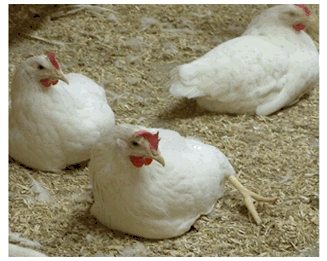 The LayWel database contained data from 20 flocks on the use of the dustbathing area (mainly Swedish data from partner SLU on LSL hens, Deliverable 4.6). Only data from small furnished cages were available. These data showed an extremely variable use, from 5 to nearly 100% of the dustbathing areas occupied by hens at a given time of observation. There was a significant effect of cage model, the highest use of dustbaths being 81% in Big Dutchman Aviplus, 46% in Victorsson Trivselsbur, 22% and 21% in treatments Triotec Stimulansbur and Hellmann Miljösystem, respectively. In all types hens had 5 hour access to the dustbaths daily. The very high variability could partly be due to the sampling technique, as use of the dustbaths varies over the day, and thus is prone to sampling errors. No effect of season could be seen.
The LayWel database contained data from 20 flocks on the use of the dustbathing area (mainly Swedish data from partner SLU on LSL hens, Deliverable 4.6). Only data from small furnished cages were available. These data showed an extremely variable use, from 5 to nearly 100% of the dustbathing areas occupied by hens at a given time of observation. There was a significant effect of cage model, the highest use of dustbaths being 81% in Big Dutchman Aviplus, 46% in Victorsson Trivselsbur, 22% and 21% in treatments Triotec Stimulansbur and Hellmann Miljösystem, respectively. In all types hens had 5 hour access to the dustbaths daily. The very high variability could partly be due to the sampling technique, as use of the dustbaths varies over the day, and thus is prone to sampling errors. No effect of season could be seen.
Given larger litter area in single floor housed Shaver 579 (data from Univbris, see Deliverable 4.6) there was an increase in the percent birds performing dustbathing. Given the same litter area more hens perform dustbathing at the lower group size.
Use of perches
In Figure 3 is shown that the use of perches at night is higher in the smaller compared to medium or larger furnished cages. All data from FCL and FCM are from one partner only (PV) and for this partner the use of perches were 64, 64 and 74% on average for FCL, FCM and FCS respectively. For the other partners, SLU and UZ, resp. 87 and 82% of hens used perches at night in FCS. In non-cage systems our data is sparse, but there seems to be a better use of perches in multi-tier systems (comparable to the level seen in small furnished cages) compared to single-tier systems. The main part of the data was on White Leghorn (LSL) hens. 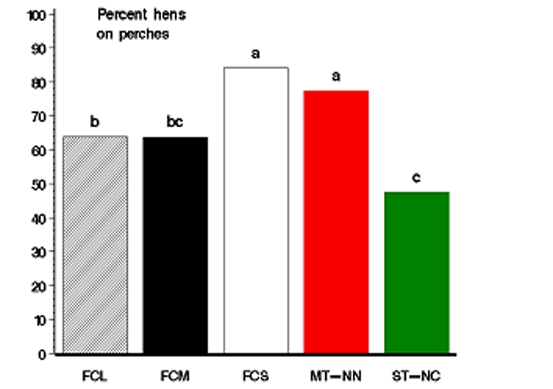
Figure: The percentage of hens (ls-means) using the perches at night in furnished cages
(FCL = large, FCM = medium and FCS = small group size) and multi tier, non-interg. nests (MT-NN) or single tier (ST-NC) non cage systems. N=114 obs. (Swedish (SLU), Dutch (PV) and Spanish (Unizar) data) Deliverable 4.6
Use of nests
A total of 146 flocks were available in the LayWel-database with recordings of percentage of eggs laid in the nests. Discarding flocks with crossed line birds or mixed flocks there was 134 flocks left. These flocks were reasonably well distributed over systems with 19% in FCL, 8% in FCM, 29% in FCS, 23% in MT and 22% in ST systems. Forty two percent were White Leghorn and 58% Medium Heavy. The distribution of flocks over systems, hen types and partners can be seen in Table 7 in deliverable 4.6.
Because Medium Heavy birds were not represented in FCL cages a two step approach was chosen. Firstly, analysis of variance was made on the two hen types separately with a model including systems. The results are shown in Table 8 in Deliverable 4.6. White Leghorns laid more eggs in nests in FCM compared to FCL and FCS and MT with ST in between. Medium Heavy hens laid more eggs in nests in non cage systems compared to furnished cages. Secondly, a further analysis was made using a model including system, hen type and their interaction. This time data on FCL cages were not included. The LS-means were identical to those given in Table 1 and very significant effects of system, hen type and their interaction were found. White Leghorns used the nests in FCM and FCS better than Medium Heavy hens (indicated by different capital letters in Table 1), while no difference was found in non cage systems. 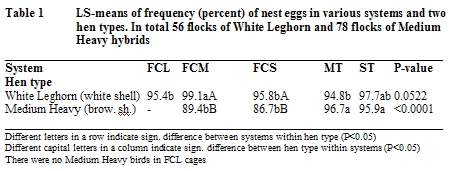
Use of space for other behaviours
Aggressive social interactions
The LayWel database contained data on pecking behaviours from 35 flocks of various breeds (LSL, ISA White, Hyline White and Lohmann Brown) kept in furnished cages (Sweden) and in 6 flocks kept in a single tier non cage system (UK), all of the Shaver 579 hybrid.
Aggressive pecking was not influenced by production system. But as for feather pecking an effect of season was found significant. Less aggressive pecking (P<0.05) was recorded in the furnished cages in the spring (0.05 pbh) compared to the other seasons (from 0.18 to 0.24 pbh).
There were higher levels of aggressive pecking in Shaver 579 flocks kept at lower group sizes (Figure 4) and this could very well have had an influence on the level of feather pecking as described above in the data from Univbris. 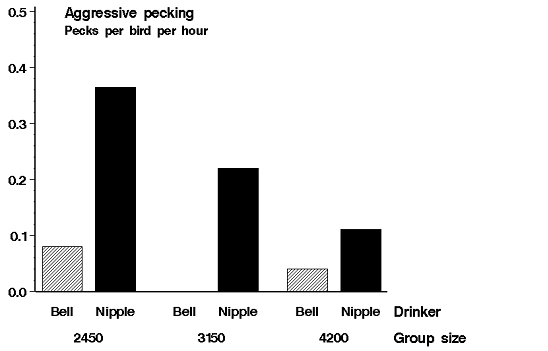
Figure 4 Aggressive pecking in Shaver 579 Leghorn hens as affected by drinker and
group size. Data from UK, Univbris, Deliverable 4.6
Frequencies of preening
Data on preening frequency were provided from Univbris on 6 flocks kept in single tier non cage systems, all of the Shaver 579 hybrid and results are shown in Figure below. 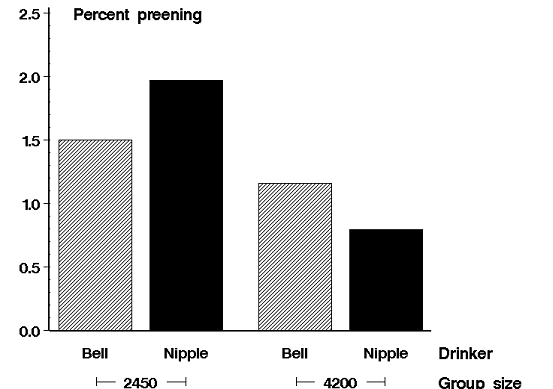
| Description | download |
| 4.5 Evaluation of litter quality in various housing systems | |
| 4.6 Behavioural function of production systems for laying hens |